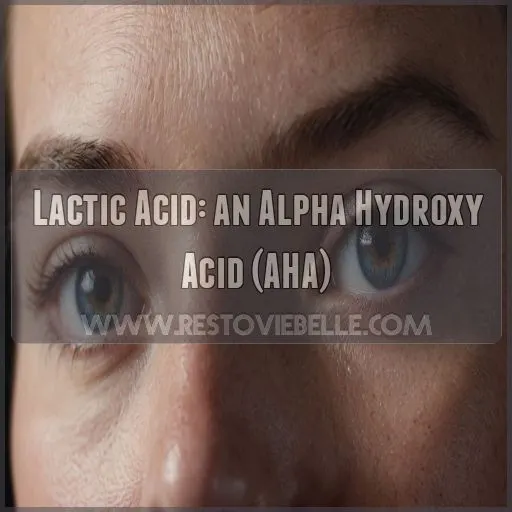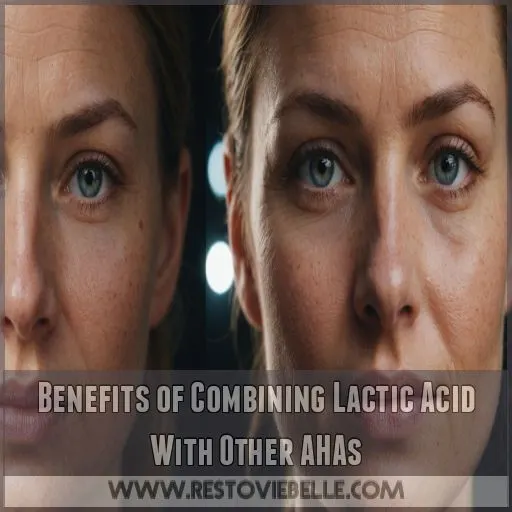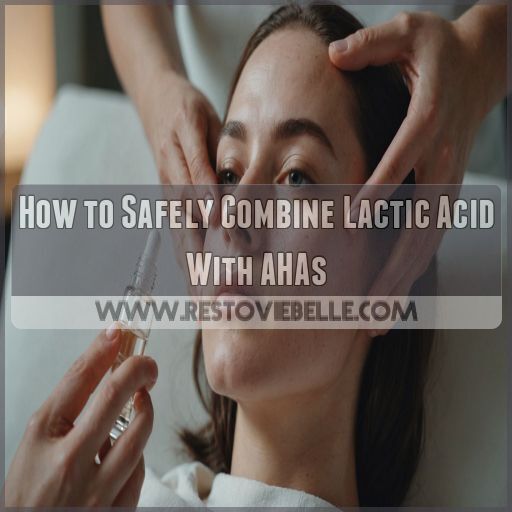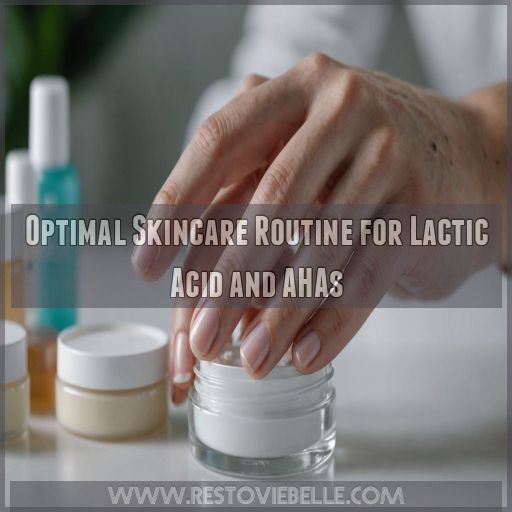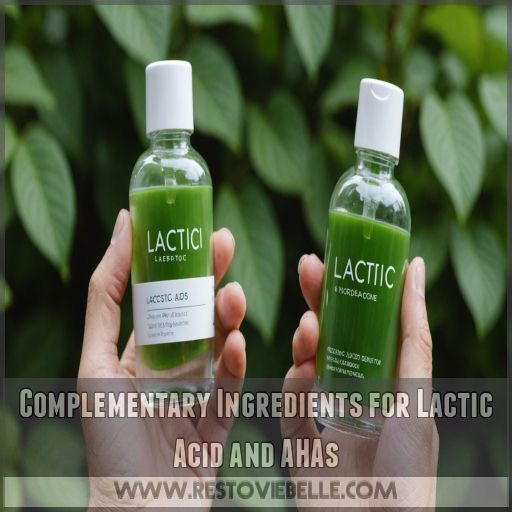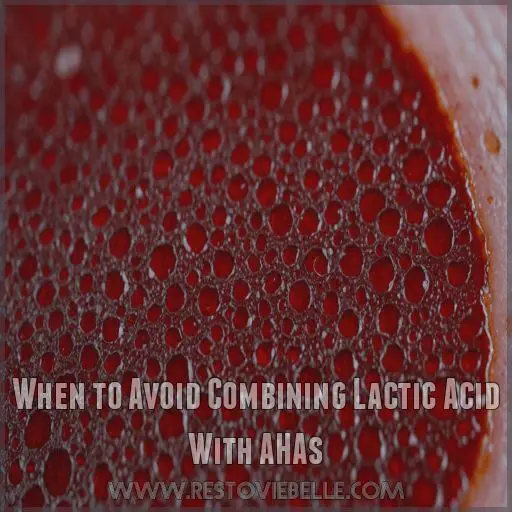This site is supported by our readers. We may earn a commission, at no cost to you, if you purchase through links.
 Yes, you can use lactic acid and AHAs together, but do it like you’re mastering a new dance routine—step by step! Lactic acid, being the gentle giant of the AHA world, partners well with others, enhancing exfoliation and brightening your complexion.
Yes, you can use lactic acid and AHAs together, but do it like you’re mastering a new dance routine—step by step! Lactic acid, being the gentle giant of the AHA world, partners well with others, enhancing exfoliation and brightening your complexion.
But beware of over-exfoliating—your skin might raise the white flag! Start with a patch test, introduce each acid gradually, and always listen to your skin’s cues. Layer serums gently and don’t forget sunscreen, your skin’s BFF.
Ready to glide into glow-town? Read on for a breakdown of a skin-loving routine that’ll have your face doing a happy dance!
Table Of Contents
- Key Takeaways
- Lactic Acid: an Alpha Hydroxy Acid (AHA)
- Types of AHAs and Their Characteristics
- Benefits of Combining Lactic Acid With Other AHAs
- Potential Risks of Using Multiple AHAs Together
- How to Safely Combine Lactic Acid With AHAs
- Optimal Skincare Routine for Lactic Acid and AHAs
- Complementary Ingredients for Lactic Acid and AHAs
- When to Avoid Combining Lactic Acid With AHAs
- Frequently Asked Questions (FAQs)
- Can I use AHA with lactic acid?
- Can I use the ordinary AHA BHA with lactic acid?
- What Cannot be mixed with lactic acid?
- What is best paired with lactic acid?
- Can lactic acid be used with retinol?
- How long should I wait between applying lactic acid and other actives?
- Can lactic acid be used during the day?
- What are the signs of overexfoliation from lactic acid?
- How do I determine the right concentration of lactic acid for my skin?
- Conclusion
Key Takeaways
- You can combine lactic acid and AHAs, but start slowly—think of it like introducing your skin to a new friend. Begin with a patch test and gradually work them into your routine. Your skin will appreciate a gentle approach.
- Don’t overdo it! Using too many AHAs at once is like inviting everyone to a party and forgetting the space is limited. Over-exfoliation can make your skin feel like it’s been put through a wringer, so listen to what it’s telling you.
- sun protection is your best buddy here. Since lactic acid and AHAs can make your skin more sensitive to the sun, make sure you’re using a good sunscreen. Nobody wants their skin to end up looking like a sundried tomato.
- Pair these acids with hydrating ingredients like hyaluronic acid or soothing ingredients like niacinamide. Consider them the perfect complement to keep your skin happy while you get that radiant glow.
Lactic Acid: an Alpha Hydroxy Acid (AHA)
You may know lactic acid as something in yogurt, but in skincare, it takes on the role of a gentle exfoliating hero as an Alpha Hydroxy Acid (AHA).
Lactic acid is known for its sizeable molecular structure, which tends to make it more of a friendly giant, gently shedding dead skin cells without causing irritation.
Chemical Structure of Lactic Acid
Lactic acid, a gentle alpha hydroxy acid (AHA), has a unique chemical structure that sets it apart.
With a molecular weight of 90.08 g/mol, it’s larger than other AHAs, allowing for more gradual skin penetration and reduced irritation – perfect for even the most sensitive complexions.
Its solubility in water and acidic pH make it an effective yet gentle exfoliant.
Natural Sources of Lactic Acid
Lactic acid isn’t just a fancy term in your skincare routine; it’s a friendly face found in fermented foods. Think sour milk, yogurt production, and dairy products where lactic acid bacteria work their magic.
Lactic acid is easily available in everyday foods.
Here’s what’s fascinating:
- Boosts AHA benefits
- Naturally exfoliates skin
Mother Nature sure knows her skincare secrets!
Molecular Size and Skin Penetration
You just explored lactic acid’s sources.
Now, with its larger molecular size, it caresses your skin gently.
Imagine it like a considerate guest who doesn’t overstay its welcome.
Unlike smaller molecules like glycolic acid, it doesn’t penetrate deeply, respecting the skin barrier.
This allows better ingredient absorption without irritation.
Perfect for sensitive skin days, isn’t it?
Exfoliating Properties of Lactic Acid
Just like how a cup of coffee kick-starts your morning, lactic acid gently nudges your skin’s exfoliation process.
With its larger molecular size, it’s perfect for sensitive skin and tackling aging woes, ideal for sensitive skin.
Here’s how it works its magic:
- Breaks down dead skin cells.
- Evens out hyperpigmentation.
- Enhances overall beauty products performance.
It’s your skin’s best friend for chemical peel benefits!
Types of AHAs and Their Characteristics
Lactic acid is just one member of the alpha hydroxy acid (AHA) family.
From glycolic acid to mandelic acid, each AHA has its own unique characteristics and benefits for the skin.
Glycolic Acid
Lactic acid may be gentle, but when you’re looking for a stronger exfoliant, glycolic acid steps up to the plate!
Known for its smaller molecules, glycolic acid penetrates more effectively, enhancing cell turnover and leaving your skin smooth.
Beauty experts rave about its benefits, but remember: each skin type responds differently.
So, which works for you—glycolic or lactic?
Mandelic Acid
Mandelic acid is a gentle AHA, perfect for sensitive skin seeking smoother skin without the drama.
Unlike lactic acid, mandelic penetrates slowly, minimizing irritation.
It’s a godsend for tackling acne and hyperpigmentation.
Think of it as your skin’s laid-back friend, quietly working wonders while you nap.
Ideal for sensitive types or newbies avoiding the roller-coaster ride of harsher acids.
Citric Acid
Speaking of AHAs, let’s chat about citric acid.
Found in citrus fruits, it’s your skin-brightening buddy.
While gently exfoliating, it keeps your skin’s pH balance in check.
Think of it as your DIY mask superstar!
Pairing citric acid with lactic acid boosts your skincare game, but remember: moderation is key, or you’ll be skating on thin ice!
Malic Acid
Malic acid, derived from apples, is another versatile AHA with a few unique benefits. It can enhance skin cell turnover, minimize the appearance of fine lines, and improve overall complexion. Unlike lactic acid, malic acid has a smaller molecular size, allowing deeper penetration. When combined with other AHAs like lactic acid, it can create a synergistic exfoliating effect.
Benefits of Malic Acid:
- Natural source: Apples
- Smaller molecular size than lactic acid
- Boosts skin cell turnover
- Minimizes fine lines and wrinkles
- Enhances complexion when combined with other AHAs
Tartaric Acid
Tartaric acid, found in grapes and bananas, offers a gentle touch in skincare.
It might not outshine lactic acid’s humectant skills, but Tartaric adds pizzazz to your regimen.
Think of it as a beauty insider’s secret weapon!
Pairing it with lactic acid? Sure thing. Together, they break down barriers like keratosis pilaris, without the physical exfoliation hassle.
Benefits of Combining Lactic Acid With Other AHAs
Combining lactic acid with other AHAs is like a team effort for your skin, giving it an extra boost by enhancing exfoliation and improving texture.
You’ll see benefits like increased collagen production and accelerated cell turnover, making your skin look fresher and feel smoother.
Enhanced Exfoliation
You’ve just tackled AHAs, now imagine adding lactic acid to the mix for extra oomph.
This AHA synergy turbocharges your skin’s exfoliation journey, much like having a cleanup crew working overtime.
Lactic acid and others weave together, gently sweeping away dullness.
When skin texture’s smoother, it’s like finding hidden treasure beneath layers—cell turnover in turbo mode, minus roughness!
Improved Skin Texture and Tone
Combining lactic acid with other AHAs can work wonders for your skin’s texture and tone.
The synergistic effects help slough off dull, uneven surface cells, revealing a smoother, more radiant complexion.
Say goodbye to rough patches and dullness – this dynamic duo will leave your skin looking and feeling its absolute best.
Increased Collagen Production
While you’re smoothing out skin texture with lactic acid, your skincare routine can also support increased collagen production, much like sipping collagen supplements like those found in a popular Korean exfoliator.
This dual approach tackles age-related decline in skin firmness.
Consider topical treatments with a blend of AHAs to boost elasticity.
Think of it as a power-packed diet for your skin, leaving it vibrant and youthful.
Accelerated Cell Turnover
Harnessing the power of AHAs like lactic acid can do wonders for your skin renewal process.
Picture your skin as a bustling metropolis, constantly regenerating.
By boosting cell turnover, it’s like you’re fast-tracking those cellular commuters, heading toward brighter, smoother avenues.
Enjoy anti-aging benefits as they help rejuvenate skin texture and bring out those fabulous brightening effects.
It’s a skincare revolution!
Potential Risks of Using Multiple AHAs Together
Using multiple AHAs together can make your skin as sensitive as a lobster at a beach party! While mixing lactic acid with other potent acids may boost your skincare game, it also poses risks like irritation, over-exfoliation, and increased sun sensitivity, potentially leaving your skin’s barrier feeling overwhelmed when using lactic acid and retinol together.
Mixing AHAs can be beneficial, but it’s important to be aware of the potential risks.
Over-exfoliation can weaken the skin’s barrier, making it more susceptible to irritation and damage.
Increased sun sensitivity can lead to sunburns and premature aging.
Skin Irritation and Sensitivity
Whoa, slow down there! Using lactic acid and other AHAs together can be a real skin minefield if you’re not careful.
Sensitive skin types, watch out – these potent exfoliants can cause redness, stinging, and irritation if you overdo it.
Always patch test first, and listen to what your skin’s telling you. Moderation is key to keeping your complexion happy and healthy.
Over-exfoliation and Barrier Damage
Sometimes, combining too many AHAs can lead your skin to over-exfoliation, leaving your barrier as flimsy as a crepe. You might notice redness or irritation—a clear SOS from your sensitive skin when experiencing common triggers for reactive skin!
Skin barrier repair is key to keeping your skincare routine balanced.
Practice moderation, because even your face needs a day off. Remember, too much of a good thing isn’t always better!
Increased Sun Sensitivity
When you mix lactic acid with other AHAs, it’s like sending your skin on a sun-loving vacation without sunscreen.
This potent combo can boost sun sensitivity and lead to both sunburn and photoaging.
So, be sure to slather on a high SPF sunscreen for solid sun protection.
After all, nobody wants their radiant skin to resemble a sun-dried tomato!
PH Imbalance in Skincare Routine
Mixing lactic acid with other AHAs can cause a pH imbalance, disrupting your skin’s natural acid mantle.
It’s like hosting a party where everyone fights over the music playlist!
To avoid chaos, make sure products are compatible.
Buffering agents can help, but a pH test strip is your trusty sidekick in testing products and keeping harmony in your skincare lineup.
How to Safely Combine Lactic Acid With AHAs
Combining lactic acid and other AHAs can be a powerful way to boost your skin’s glow, but you’ll want to take it slow.
Start by patch testing new acid blends and gradually introduce them into your routine.
Adjust concentrations as your skin adjusts.
Patch Testing New Combinations
Diving head-first into new skincare? Best not! Always do a patch test to keep your skin happy.
To avoid any unwanted surprises:
- Test frequency: Once before full use
- Duration: 24-48 hours
- Size: Coin-shaped area
- Location: Forearm or behind the ear
- Reactions: Monitor redness or irritation
Better safe than sorry!
Gradual Introduction of Multiple Acids
Trying out acids? Start low to see how your skin reacts and build up your tolerance.
Like making smooth lemonade—add a little, then adjust.
Introduce one acid at a time, allowing your skin to adapt before you layer another.
This gradual approach helps keep irritation away while helping you get a radiant complexion.
Adjusting Concentration and Frequency of Use
If you’re juggling different acids, think of it like dancing to a new tune—start slow. Begin with a lower concentration of lactic acid. Frequency adjustments help avoid skin drama. Imagine romancing your skin with gentle attention.
Start with a low concentration of lactic acid.
Adjust frequency based on your skin’s behavior.
Monitor for any irritation.
Gradually increase the concentration as your skin’s tolerance builds.
- Start with low concentration
- Adjust frequency based on skin’s behavior
- Monitor for any irritation
- Gradually increase as tolerance builds
Monitoring Skin’s Response and Tolerance
As you start incorporating lactic acid and AHAs into your routine, keep a close eye on your skin’s response.
Patch test new combinations first, then slowly increase frequency and concentration as your skin builds tolerance.
Listen to your complexion – if it feels irritated or inflamed, scale back until it calms down.
Moderation is key for glowing, healthy skin.
Optimal Skincare Routine for Lactic Acid and AHAs
Figuring out the best skincare routine for using lactic acid and other AHAs together can feel like solving a puzzle, but don’t worry, we’ve got the pieces.
You’re about to learn how to effectively cleanse, layer, and protect your skin with these power-packed exfoliants—just imagine them as a dream team working double time to give you that fresh glow!
Cleansing and Preparing the Skin
Before you dive into AHAs, start with gentle cleansing to lay the groundwork. Here’s your game plan:
- Gentle Cleansing: Choose a cleanser that respects your skin’s pH balance, leaving it refreshed but not stripped.
- Exfoliation: Pre-treatment is important, but don’t overdo it.
- Skin Hydration: Apply a hydrating serum to keep that skin barrier happy.
Application Order and Timing
Great job prepping your skin! Now, let’s chat about applying lactic acid and AHAs. Morning vs. Evening routines can influence effects. Scratch your noggin and consider frequency—don’t overdo it!
Layering products from thinnest to thickest helps. Here’s a peek at order and timing:
| Morning | Evening | Product Types |
|---|---|---|
| Cleanser | Serum | Lactic Acid |
| Toner | Moisturizer | AHAs |
| SPF | Treatment | Hydrator |
Seeing clearer skin already?
Moisturizing and Hydrating Steps
After applying lactic acid, be sure to follow up with hydrating serums and a moisturizer.
Layering humectants like hyaluronic acid helps draw moisture into the skin, while occlusive ingredients seal it in.
Completing your hydration routine with these steps makes sure your complexion stays supple and healthy, even as the lactic acid gets to work.
Sun Protection Measures
Ah, the sun, both our friend and foe.
When using lactic acid and AHAs, you’ve got to protect that precious skin of yours.
With increased sun sensitivity, a solid SPF routine is a must.
Choose broad-spectrum sunscreen to prevent skin cancer, debunk sun protection myths, and keep pesky rays at bay.
So, slather it on and enjoy!
Complementary Ingredients for Lactic Acid and AHAs
You’ll want to boost the benefits of lactic acid and AHAs by pairing them with powerhouse ingredients like hyaluronic acid, niacinamide, and ceramides.
Think of it as a skincare smoothie that’s both delicious for your skin and effective in keeping your complexion glowing and protected.
Hyaluronic Acid for Hydration
Before moving on, let’s chat about hyaluronic acid (HA). It’s a hydration superhero! Whether your skin’s dry or oily, HA offers flexibility like a yoga master.
Consider these advantages:
- Moisturizes without making you greasy.
- Benefits highlighted in many HA serum reviews.
- Balances HA vs. glycerin usage.
- Works wonders for thirsty skin types.
Give it a shot!
Niacinamide for Barrier Support
Niacinamide, a skincare superstar, teams up with lactic acid and AHAs to fortify your skin’s protective barrier.
This dynamic duo helps calm redness, minimize breakouts, and enhance hydration – all while supporting your skin’s natural renewal process.
Pair niacinamide with your lactic acid routine for a complexion that glows with confidence.
Ceramides for Moisture Retention
Ceramides, your skin’s unsung heroes, work wonders for moisture retention, just like a comfy blanket on a chilly night.
Unlike niacinamide’s barrier support, ceramides act as a glue holding skin cells together.
If you’ve got ceramide deficiency, ceramide-rich products or supplements can save the day, offering superior moisture compared to humectants.
So, consider them your skin’s building blocks!
Antioxidants for Free Radical Protection
You’ve tackled moisture retention, now onto the superhero team—antioxidants. Think of them as your skin’s invisible shield against free radical damage. Here are your sidekicks:
- Antioxidant Benefits: Boost skin defense.
- Free Radical Damage: Fight aging signs.
- Skin Protection: Vitamin C’s forte.
- Antioxidant Serums: Pack these bottles of power.
Skincare’s a puzzle; antioxidants complete it!
When to Avoid Combining Lactic Acid With AHAs
Figuring out skincare can be tricky, especially when deciding if lactic acid and other AHAs should mix—think of it like merging two strong personalities on a reality show, and ask yourself if your skin might need a calmer cast!
If you have sensitive skin, are using retinoids, or are pregnant or breastfeeding, it might be wise to hit pause on this combo to avoid unwanted drama on your skin.
Pre-existing Skin Conditions or Sensitivities
If you have pre-existing skin conditions like acne, rosacea, eczema, or psoriasis, it’s best to avoid combining lactic acid with other AHAs. These powerful exfoliants can further irritate and sensitize your already compromised skin barrier. Instead, opt for gentler, soothing ingredients suited to your specific needs.
Skin conditions like acne, rosacea, eczema, and psoriasis can be aggravated by AHAs, so it’s best to avoid combining them.
| Skin Condition | Avoid Combining With AHAs |
|---|---|
| Acne | Yes |
| Rosacea | Yes |
| Eczema | Yes |
| Psoriasis | Yes |
| Sensitive Skin | Yes |
Use of Retinoids or Other Active Ingredients
When juggling retinoids alongside lactic acid and AHAs, you’re playing with skincare chemistry! Mixing them can spark irritation. Here’s the lowdown:
- Use retinoids at night, AHAs in the morning.
- Space applications, giving skin time to breathe.
- Trust your skin’s pace; not everyone can party with both!
- Watch for redness—your skin’s SOS signal.
Pregnancy and Breastfeeding Considerations
During pregnancy, figuring out skincare safety feels like tiptoeing through a minefield. Staying clear of combining lactic acid with other AHAs is wise to prevent increased skin sensitivity and potential irritation. Your skin’s unpredictable during these times, so it’s important to stick to gentler options. Consult with a dermatologist before diving into your product selection.
Hormonal changes during pregnancy can cause unpredictable reactions in your skin.
Skin sensitivity is also a concern during pregnancy, putting you at increased risk of irritation.
Product absorption is another important consideration, especially for breastfeeding mothers.
Dermatological advice is essential for choosing safe and effective skincare products during pregnancy.
| Consideration | Impact | Recommendation |
|---|---|---|
| Hormonal changes | Unpredictable skin reactions | Opt for milder ingredients |
| Skin sensitivity | Increased risk | Patch test diligently |
| Product absorption | Breastfeeding concerns | Dermatological advice |
Frequently Asked Questions (FAQs)
Can I use AHA with lactic acid?
Mixing lactic acid with other AHAs might feel like inviting too many exfoliating guests to your skin party.
They can coexist, but let each have its moment.
Alternate usage to avoid overwhelming your skin with too much action.
Can I use the ordinary AHA BHA with lactic acid?
You can definitely use The Ordinary’s AHA BHA with lactic acid, but space them out like party guests at a crowded room.
Try using one in the morning, the other in the evening for best results.
What Cannot be mixed with lactic acid?
94% of skincare users mix products without realizing some shouldn’t be mixed!
Avoid pairing lactic acid with retinol, as it can lead to irritation.
Think of it like mixing oil and water—better to keep them separate!
What is best paired with lactic acid?
Lactic acid pairs beautifully with other gentle exfoliants like glycolic acid or vitamin C, as seen in the skin care benefits of using glycolic acid and vitamin C together.
Introduce these exfoliants slowly, alternating days or allowing time between applications to avoid irritation.
Your skin will thank you for the glow-boosting combo!
Can lactic acid be used with retinol?
Did you know 90% of skincare experts suggest separating lactic acid and retinol?
Mixing them can cause irritation, like a cat fight on your skin.
Try alternating nights or allowing time between their applications for harmony.
How long should I wait between applying lactic acid and other actives?
Give your skin a rest between applying lactic acid and another active ingredient—about 10-15 minutes should do the trick.
This helps prevent irritation and makes sure each product gets absorbed properly, putting your skin care routine in tip-top shape.
Can lactic acid be used during the day?
Sure, you can use lactic acid during the day, but be a smart cookie and wear sunscreen.
Lactic acid might increase your skin’s sensitivity to the sun, so protection is a must to prevent potential damage.
What are the signs of overexfoliation from lactic acid?
Overexfoliation from lactic acid can cause redness, irritation, dryness, and increased sensitivity.
If your skin feels tight, stings, or appears inflamed, it’s time to scale back your lactic acid usage and focus on soothing, hydrating products.
How do I determine the right concentration of lactic acid for my skin?
Picture your skin as a delicate painting; not every shade fits.
Start with a gentle 5% lactic acid concentration.
Let your skin decide if it’s happy.
Increase slowly.
Just don’t leap before you look!
Conclusion
Imagine 75% of skincare enthusiasts blissfully using lactic acid and AHAs together for that radiant glow.
With care, you can be part of this luminous tribe. Start slowly to avoid skin rebellion and sun-sensitivity.
Listen to your skin—it’ll guide you better than any tutorial. Your skincare journey can flourish; just remember sunscreen remains your skin’s trusty shield.
Ready to dance into glow-town while mastering how to use lactic acid and AHA together? You’ve got this!

